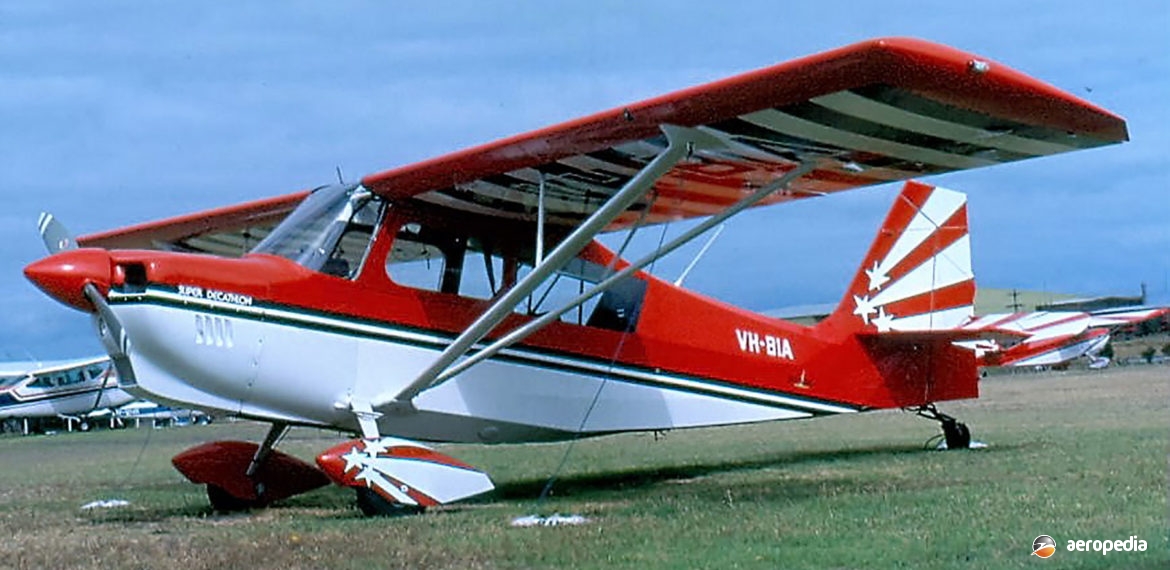Photograph:
Bellanca 8KCAB Decathlon VH-BIA (c/n 555-79) at Moorabbin, VIC in April 1980 (David C Eyre)
Country of origin:
United States of America
Description:
Two-seat fully-aerobatic cabin monoplane
Power Plant:
One 134 kw (180 hp) Lycoming AEIO-360-H1B fuel-injected inverted systems four-cylinder horizontally-opposed air-cooled engine
Specifications:
- Wingspan: 9.75 m (32 ft)
- Length: 6.98 m (22 ft 10¾ in)
- Height: 2.36 m (7 ft 9 in)
- Wing area: 15.71 m² (169.1 sq ft)
- Max speed at 2,135 m (7,000 ft): 254 km/h (158 mph)
- Cruising speed at 75% power: 241 km/h (150 mph)
- Stalling speed: 84 km/h (52 mph)
- Initial rate of climb: 375 m/min (1,230 ft/min)
- Service ceiling: 5,245 m (17,200 ft)
- Take-off run: 151 m (495 ft)
- Landing run: 130 m (425 ft)
- Range no reserve at 75% power: 944 km (587 miles)
- Range at 55% power: 1,006 km (625 miles)
- Fuel capacity: 151 litres (33 Imp gals)
- Empty weight: 596 kg (1,315 lb)
- Loaded weight: 816 kg (1,800 lb)
History:
Following Bellanca’s acquisition of the Champion Aircraft Corporation in September 1970, production of the fully aerobatic model of the Citabria, the Model 7DCAB, was continued. In order to distinguish it from the other models, this model was renamed the 8KCAB Decathlon. Fitted with an inverted flight fuel and oil system, the Decathlon could be flown inverted for up to four minutes without loss of oil or oil pressure, and was stressed to +6G and 5G for unlimited aerobatics.
In appearance, the Decathlon was very similar to the Model 7 Citabria. The model of the engine fitted and the up-graded structural strength of the Decathlon for aerobatics were the main differences. Structural differences between the Decathlon and other models included the modified wing section to an NACA 1412 semi-symmetrical section to cope with inverted performance and other unusual flight attitudes, the trimming of the wingspan by 45.72 cm (18 in), the addition of more ribs in the wing, and heavier struts. Also, a Hartzell constant speed propeller replaced the Sensenich type. The Decathlon was also offered with a 134 kw (180 hp) Lycoming AEIO-360-HIA engine or the 112 kw (150 hp) AEIO-320-E1B engine with fuel injection. The wing had aluminium alloy spars and ribs, being Dacron covered, and GFRP wingtips. The fuselage and tail unit were welded steel tube structure and also Dacron covered.
The Decathlon first became prominent in this region when, in 1977, Squadron Leader Donald Pollock of the RAAF won the Queen’s Silver Jubilee Air Show Aerobatic Championship. Subsequently the type became a regular performer at airshows but in later years has been overtaken by specialised aerobatic types.
More than 30 examples of the type have been seen in this region. Production of the series was continued by American Champion, models available including the 7GCAA Adventure, 7ECA Aurora, 7GCBC Citabria Explorer, 8KCAB Super Decathlon and 8GCBC Scout.

